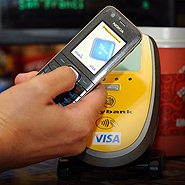 August 17, 2011 – Visa has signalled its determination to push the United States into abandoning mag-stripe cards in favour of EMV chip technology; a move it says will not only improve security but accelerate the adoption of contactless mobile payments.
August 17, 2011 – Visa has signalled its determination to push the United States into abandoning mag-stripe cards in favour of EMV chip technology; a move it says will not only improve security but accelerate the adoption of contactless mobile payments.
The clamour for America to join Europe and take up chip and PIN has been growing over the last year, with retailers and bankers voicing concern over the fraud risks associated with mag-strip technology. Now card giant Visa has set out its programme to drive the adoption of dual-interface chip technology to „help prepare the US payment infrastructure for the arrival of NFC-based mobile payments” as well as improve security and international interoperability.
 Visa Inc. recently announced plans to accelerate the migration to EMV contact and contactless chip technology in the United States. The adoption of dual-interface chip technology will help prepare the U.S. payment infrastructure for the arrival of NFC-based mobile payments by building the necessary infrastructure to accept and process chip transactions that support either a signature or PIN at the point of sale.
Visa Inc. recently announced plans to accelerate the migration to EMV contact and contactless chip technology in the United States. The adoption of dual-interface chip technology will help prepare the U.S. payment infrastructure for the arrival of NFC-based mobile payments by building the necessary infrastructure to accept and process chip transactions that support either a signature or PIN at the point of sale.
„By encouraging investments in EMV contact and contactless chip technology, we will speed up the adoption of mobile payments as well as improve international interoperability and security,” said Jim McCarthy, global head of product, Visa Inc. „As NFC mobile payments and other chip-based emerging technologies are poised to take off in the coming years, we are taking steps today to create a commercial framework that will support growth opportunities and create value for all participants in the payment chain.”
Not only will chip technology accelerate mobile innovations, it is also expected to secure payments into the future through the use of dynamic authentication. Chip technology greatly reduces a criminal’s ability to use stolen payment card data by introducing dynamic values for each transaction. Even if payment card data is compromised, a counterfeit card would be unusable at the point of sale without the presence of the card’s unique elements. By reducing static authentication, we diminish the value of stolen cardholder data, benefiting all stakeholders.
„Dynamic authentication is the key to securing payments into the future,” said Ellen Richey, chief enterprise risk officer, Visa Inc. „Adding dynamic elements to transactions makes account data less attractive to steal and takes more merchant systems out of harm’s way, shrinking the battlefield against criminals. The migration to chip technology will be an important security layer and a critical step in a comprehensive strategy to use dynamic authentication across all markets and all channels.”
Globally, Visa will continue to support a range of cardholder verification methods including signature, PIN and no-signature for low-value, low-risk transactions. In the longer term, we expect that the use of static verification methods such as signature and PIN will be reduced or eliminated entirely as new and dynamic forms of cardholder verification are implemented.
Visa’s plan to encourage the U.S. adoption of dynamic chip authentication technology includes the following three initiatives:
Today’s announcement builds on similar international programs to encourage the migration to EMV chip. In February 2011, Visa announced the Technology Innovation Program for international merchants. The program, which was available beginning March 31, 2011, was intended to recognize the security benefits of dynamic authentication, enabled by EMV chip, and offer tangible benefits to merchants who update their POS infrastructure to accept chip cards. Visa has now expanded this program to include U.S. merchants, but will require terminals to support both contact and contactless chip payments.
Moving forward, as the point-of-sale payment infrastructure evolves from the static magnetic stripe to intelligent devices such as EMV chip cards and NFC mobile phones, it is critical to ensure that cardholders can continue to conduct convenient, secure and reliable payments for card-not-present transactions as well. Visa is designing its new digital wallet with „click-to-buy” functionality able to support dynamic authentication across multiple channels including the eCommerce environment. Visa will also continue to enhance intelligent network-based fraud detection tools such as Visa Advanced Authorization and cardholder transaction alerts to complement dynamic and risk-based authentication methods.? As always, effective fraud prevention requires multiple layers of security.
Industry Support
The announcement supports an increasing interest in chip technologies from across the industry:
Banking 4.0 – „how was the experience for you”
„To be honest I think that Sinaia, your conference, is much better then Davos.”
Many more interesting quotes in the video below: